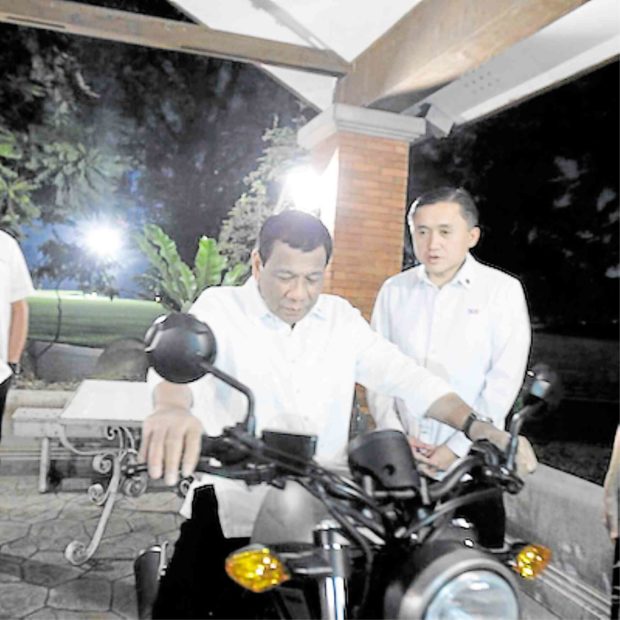Duterte in pain: Doctors weigh in

GET YOUR MOTOR RUNNING President Duterte took a nighttime ride on a big bike at the Presidential Security Group compound on Oct. 16, according to his longtime aide, Sen. Bong Go. -BONG GO’S FACEBOOK PAGE
MANILA, Philippines — It is possible that President Rodrigo Duterte’s recent fall from a motorcycle caused the muscle spasm that forced him to leave Japan in the middle of the celebration of Emperor Naruhito’s enthronement last week, according to two doctors who are not treating him for any medical condition.
Sharing their insights at the Inquirer’s request, Dr. Rafael R. Castillo, a senior consultant in cardiology at Manila Doctors Hospital, and Dr. Josephine G. Torres Tuason, a neurology and internal medicine specialist at Asian Hospital, said the President’s complaint about “unbearable pain” was consistent with trauma from such an accident.
The two doctors stressed that their discussion of a 74-year-old patient suffering from a muscle spasm after a motorcycle accident was hypothetical and did not necessarily refer to the President.
But while Castillo, who writes a weekly health column for Inquirer Lifestyle, urged “an elderly with a complex medical history” like the President to consider the risks of riding a motorbike at his age, Tuason said it was a senior patient’s prerogative to continue riding “as long as he is not in pain.”
Tuason explained that muscle spasm per se “is not life-threatening and can be addressed by pain relievers.” In fact, “it should not hinder” a patient “from doing his job” since pain relievers and muscle relaxants “can address the problem,” she said.
Article continues after this advertisement‘Unbearable pain’
Article continues after this advertisementConflicting versions of the President’s fall from a motorcycle on Oct. 16 were aggravated by his premature return from an official trip to Tokyo six days later due to what his spokesperson Salvador Panelo described as “unbearable pain.”
Sen. Bong Go, the President’s longtime aide, later told reporters that the President had consulted a neurosurgeon in an undisclosed hospital in Taguig City, and that magnetic resonance imaging (MRI) pinpointed the condition as “purely muscle spasms.”
The President has previously admitted suffering from Buerger’s disease, a serious inflammation of the blood vessels in the arms and legs, and Barrett’s esophagus, which is linked to heartburn and can lead to cancer.
His most recent health disclosure is of having myasthenia gravis, a serious autoimmune disease characterized by muscular weakness and fatigue.
‘Most likely culprit’
In an email interview, Castillo said a hypothetical discussion of a senior-aged individual with the same history as the President would indicate that “the most likely culprit” for muscle spasm “is the fall from his motorcycle.”
Castillo said the hypothetical individual “obviously” did not suffer a fracture “because if so, he’ll not be able to walk at all despite potent analgesics or pain killers.
He added: “It may likely be due to severe muscle spasms, which can result from injuries to the muscles, tendons and ligaments in the back.”
Castillo said that while the motorcycle accident “may be the final triggering cause” for severe spasms, it may also be “on top of longstanding or chronic arthritis in the lower back.”
The cardiologist mentioned degenerative arthritis due to a patient’s advanced age and traumatic arthritis likely caused by previous motorbike accidents among the possibilities. (The President once admitted he suffered spine injury after a motorcycle accident years ago.)
Asian Hospital’s Tuason clarified that muscle spasm “is a general symptom, not a diagnosis.”
“It is also multifactoral, meaning it can be caused by a lot of things like sports, trauma, arthritis and degenerative causes,” she said. “While it is not life-threatening, the patient would be in pain. But he can be given a muscle relaxant or pain reliever to address the problem, and this should not hinder him from doing his job. He can travel, he can walk.”
Pain is a manifestation of muscle spasm, Tuason said, adding: “The question is, ‘What caused it?’ A motorbike accident is a possible and plausible explanation. It is acceptable.”
Castillo noted that a physician handling a case like the President’s “usually requests X-rays of the spine and other bones [plus] MRI scans to rule out more serious injuries, including spine vertebral (backbone) fractures, which can impinge on the nerves, causing pain.”
Tuason opined that anyone who had a motorbike accident “should have seen the doctor right away. And if there is anything trauma-related [that is found], an X-ray should have been done depending on the evaluation of the doctor.”
She said it was the President’s neurologist “who should be announcing” such findings to the public.
Buerger’s, Barrett’s
Castillo said that in an accident like the President’s, “usually, the patient is prescribed rest, painkillers, physical therapy and/or acupuncture, avoiding lifting heavy objects … and not riding the motorcycle again.”
“It’s too risky for an elderly with a complex medical history,” Castillo said. “He can feel dizzy for a split second and if he’s running fast on a big motorbike, that can be too risky for comfort.”
Tuason declined to comment on the President’s other medical conditions, saying Barrett’s esophagus and Buerger’s disease were both “non-neurologic.”
But while myasthenia gravis is a neuromuscular disease, the condition “does not explain muscle spasm,” she said. “The common symptom is weakness, not pain.”
Again maintaining that he was speaking hypothetically, Castillo said Barrett’s esophagus could be ruled out as a cause for back muscle pains because “symptoms are centered on the stomach and esophagus, so patients usually have stomach or heartburn symptoms.”
The discomfort from Buerger’s disease, meanwhile, are from inflamed blood vessels in the arms and legs, he said.
“The arteries, therefore, get occluded, and this can cause so much pain, tissue damage and even gangrene wherein the toes or legs die or decay,” Castillo said. “But the severe pain is felt in the toes and legs, and occasionally in the lower arms—not in the back. So Buerger’s disease may also be ruled out.”